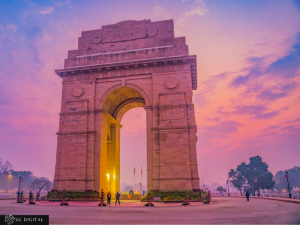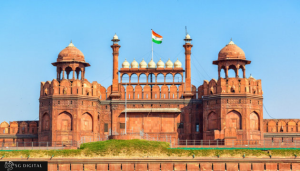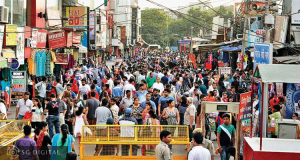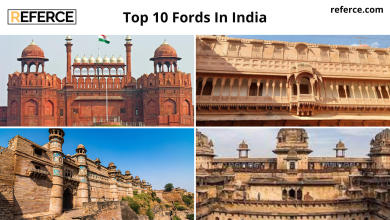Top 10 Best Places To Visit Delhi
India Gate is a prominent war memorial located in the heart of New Delhi, the capital city of India. Here are details about India Gate:
- Architectural Marvel:
- India Gate is a classic example of an arch-shaped monument built in the memory of the soldiers who died during World War I.
- The edifice’s architecture is inspired by the Arc de Triomphe in Paris; it symbolizes pride and unity for the nation.
- Location:
- India Gate is located at the far east end of Rajpath in New Delhi, India. General: All around the India Gate is having green lawns, which is common for every local citizen over there, in and around to spend their evenings.
- War Memorial:
- The All India War Memorial, later renamed the India Gate, is a war memorial that is dedicated to soldiers who died in a number of wars that include the First World War and others, arising in the course of serving in the British Indian Army.
- Inscription:
- At the base of India Gate lies Amar Jawan Jyoti, the continuous burning flame, in memory of the Unknown Soldier. It symbolizes the spirit that never dies.
- Amar Jawan Jyoti:
- Lying at the base of India Gate is Amar Jawan Jyoti, the continuous burning eternal flame in memory of the Unknown Soldier. The flame symbolizes the never-ending spirit, which can never die.
- Venue of Ceremonial Events:
- The India Gate is the venue of a number of ceremonial events, amongst which the most noted is the Republic Day Parade that occurs every year on January 26. It is a parade that starts off on either side of this monument and travels down Rajpath.
- Night Illumination:
- The illumination of the monument is such that it appears at its best during the night. It makes the monument grand and can induce a solemn but inspiring mood.
- Surrounding:
- Surrounding the India Gate, there have been the India Gate Hexagon Lawns, which are very green. Apart from that, one can also find these gardens very famous and frequently visited by people who come here for picnic walks and general relaxation.
- Accessibility:
- India Gate is most accessible and accentuates the centricity of reference in Delhi, surrounded by other important structures like Rashtrapati Bhavan and the National War Memorial.
- Historical Significance:
- The India Gate, designed by Sir Edwin Lutyens and finished in 1931, had been planned since its inception to be a dedication to the soldiers of the British Indian Army. After independence, it was re-established and had an eternal flame set under the arch to commemorate the national martyrs’ collective sacrifice.
The India Gate is much more than a monument; it is a dedication to the soldiers who sealed their courage and dedication to their motherland with their lives for justice and liberty. It resides centrally in the heart of Indians and remains a landmark in the country capital.
The Red Fort, also known as Lal Qila in Hindi, is hugely iconic among the UNESCO World Heritage Sites, located at the heart of Old Delhi in India. It epitomizes the level of Mughal architecture, entirely built during the reign of Mughal Emperor Shah Jahan.
- Historical Significance:
- Built in the 17th century, this fort remained a central residence to the Mughal emperors for two hundred years. As such, it was a seat of power in India under the two centuries of Mughals. The Great
- Architecture:
- The great architectural work at Red Fort features red sandstone walls and many white marble structures, all containing details of design. The Red Fort Complex covers an area that shows a combination of Persian, Timurid, and Indian architectural features.
- Diwan-i-Am and Diwan-i-Khas:
- Among the principal halls are Diwan-i-Am (Hall of Public Audience) and Diwan-i-Khas (Hall of Private Audience).The former hall contains the general audience, while in the latter, it was meant for private meetings.
- Rang Mahal:
- The “Palace of Colors,” this was an apartment set aside for the imperial harem. It was lavishly decorated with very bright colors, thus representing the luxury and opulence that the women of Mughal royals lived in.
- Sound and Light Show:
- An interesting sound and light show is also organized at the fort in the evening hours to depict the history and its relevance with important event’s history.
- Chhatta Chowk:
- Meaning “the covered bazaar,” is a long hall where, in days gone by, there used to be a hustling market. Today, its long galleries are used to display different sorts of exhibitions: artifacts, historical displays.
- Lahori Gate:
- Red Fort has its imposing main entrance through the Lahori Gate facing the market of Chandni Chowk. Great structure, very representative of it, with detailed carvings. Independence
- Day celebrations:
- The Red Fort has historical importance since the Prime Minister of the country hosts the national flag from the entrance of the Red Fort. Independence Day (15th August) is celebrated with a patriotic speech to the nation.
- Museum:
- The palace contains a museum with artifacts and displays from the Mughal period, which, in its turn, explains to the public the historical background and culture associated with the monument.
Red Fort is like a living history and culture heritage; it really is an example of grand architectural site and historical importance, propounding the landmark for tourist and one loving history.
3. Qutub Minar
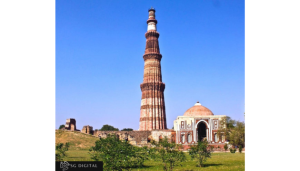
Qutub Minar, situated in Delhi, India, is a UNESCO World Heritage Site and one of the most iconic monuments of the country. Here are more details about Qutub Minar:
- Historical Background:
- Qutub Minar is a very high altitude minaret, which was built at the beginning of the 13th century by Qutb-ud-din Aibak, founder of the Delhi Sultanate, and completed under his successors.
- Architectural Wonder:
- The minaret rises up to an impressive height of 73m (240 ft) and, probably due to its height, possesses some of the finest carvings and inscriptions of Quranic verses ever made with great precision. The minaret represents one of the wonders of Indo-Islamic architecture.
- The Qutub Complex
- is the main highlight of the much larger Qutub Complex, which has many other important structures in history, with key ones being the Quwwat-ul-Islam Mosque, Alai Darwaza, Iron Pillar, and Iltutmish’s tomb.
- Quwwat-ul-Islam Mosque:
- The adjoining minaret of the first mosque that was built in India. Its construction follows the usual forms of Hindu architecture, e.g., the use of numerous columns taken from variously destroyed Hindu temples.
- Iron Pillar:
- In the premises of the Qutub Complex stands a very ancient Iron pillar, exactly in the center of the courtyard, which has been named as the “Iron Pillar of Delhi.” This is famous for its inherent property of corrosion, standing for more than a millennium.
- Alai Darwaza:
- The great Alai Darwaza stands as the testimony of architectural advance made by the Delhi Sultanate. The gate was constructed by Alauddin Khilji and bore complex geometric patterns with calligraphy inscribed on the gate.
- Tughlaqabad Fort:
- Neighboring the Qutub Complex but of contemporary character with it is the Tughlaqabad Fort, directly associated with Ghiyas-ud-din Tughlaq, who went on to extend the fortifications yet.
- Light and Sound Show:
- In the evenings, a captivating light and sound show narrating the historical events connected with the monument is hosted at Qutub Minar. The show adds an immersive experience for visitors.
- Visiting Tip:
- Visitors may visit the top of the Qutub Minar, but again, check the current status and if any restrictions are there before planning a visit. The staircase is quite narrow. There might be restrictions on the number of persons allowed at a time.
One of the best and finest examples of living heritage in the architectural and cultural glory of India is the Qutub Minar itself. This very fact does attract tourists, historians, and art lovers from the world over to come and witness the details and history it beholds amidst this vibrant city of Delhi.
4. Humayun’s Tomb
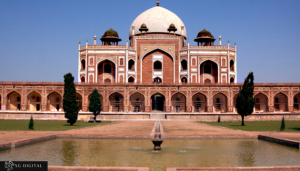
The city of Delhi contains some of the great architectural wonders of India, such as Humayun’s Tomb. Follow the links to read more information on Humayun’s Tomb.
- Historical Significance:
- The construction of the Humayun’s Tomb dates back to the 16th century, said to be the tomb for Mughal Emperor Humayun. This is great from the point of history, as it used to be the first Indian Garden-tomb.
- Architectural Style:
- It is one of the splendid samples of Mughal architectural art and is said to have inspired the construction of the Taj Mahal. The tomb was designed by a Persian architect, Mirak Mirza Ghiyas.
- Garden Setting:
- All other Mughal gardens, the tomb, stands in a charbagh (fourfold garden) setting. Divided by broad walkways into quadrants, the garden has flowing water channels with pools, together with well-maintained green lawns.
- Central Dome:
- The salient and most visible feature of the tomb is the central dome that rises to a height of 42.5 meters (140 feet). The double-layered dome is quite an architectural innovation of those times. Red Sandstone and
- White Marble:
- The basic architecture and the main building are laid using red sandstone, while the white marble finds its place in the sections of decoration along with the inlays. Thus, the combination adds more aesthetics to the monument.
- Octagonal Chambers:
- Eight chambers surround the tomb. In each chamber, there are arched openings with a top dome and contain graves from some of the royal family members.
- Chhatri and Minarets:
- His tomb is marked at every corner of the plinth with the chhatris (a structure serving as an elevated, dome-shaped pavilion). Four minarets decorate the main tomb, followed in the Mughal architectural style.
- Restoration and Conservation:
- The tomb undertook serious restorative efforts as a means to conserve historic integrity. The restoration tackled structural problems, improved the surroundings, and secured the durability of the monument.
- Complex Surround:
- The complex was equally surrounded by other buildings of the likes of the Nila Gumbad (Blue Dome), the Isa Khan Tomb, and the enclosure of Bu Halima’s Garden, hence representing general historical and architectural influences.
- Visitor Experience:
- The visitors can experience the gardens, which host many reflective pools. For example, on the facades of the tomb, one can see the symmetry and design of each element. The pools around are of the reflective type.
In fact, the tomb of Humayun demonstrates the excellency of an architect from the Mughal era and stands as an oasis for peace in the modern and noisy city of Delhi. Its name comes among the first on the UNESCO World Heritage list, highlighting its cultural and historical value.
5. Chandni Chowk
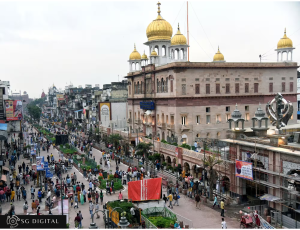
Chandni Chowk, located in the center of Old Delhi, is one of the oldest and most crowded markets in India. Buzzing with life and history, this place has been one of the most eminent commercial and cultural centers for hundreds of years. This is more on Chandni Chowk.
- Historical Significance:
- Chandni Chowk was established in the 17th century by the Mughal Emperor Shah Jahan. It was made in the form of a market square with a canal in between running so as to reflect the moonlight from it, from where the name “Chandni Chowk” (Chandni means moonlight and chowk means square).
- The area has witnessed many historical events and has been witness to the grand processions of Mughal emperors.
- Architecture and Layout:
- The Chandni Chowk was a remnant of the mixed architectural style of Mughal, Indian, and colonial. The local traditional big havelis (large private houses), the buzz of the markets, and the narrow lanes all spill out the charm which is endemic to this place.
- It is laid out in a straight line with many narrow alleys leading off to more or less specialized markets, or bazaars.
- Markets and Bazaars:
- The markets of varying nature are the major attraction in Chandni Chowk. Most of the well-established and popular markets of Delhi specialize in Dariba Kalan (jewelry), Kinari Bazaar (wedding accessories), Nai Sarak (book market), and Khari Baoli (Asia’s largest spice market).
- You can find a variety of goods, including textiles, jewelry, spices, electronics, and traditional Indian sweets.
- Places of Interest:
- Red Fort: One of the important sites to visit in Delhi, the Red Fort is also one of the UNESCO World Heritage Sites.
- Jama Masjid: Another site very important to visit in Delhi, it is one of the biggest mosques in the country, located near Chandni Chowk.
- Shri Digambar Jain Lal Mandir: This is the oldest Jain temple in Delhi and is located in the heart of Chandni Chowk.
- Street Food:
- The epicenter of fame for the food from Chandni Chowk lies with the street foods. One can locate the local flavor in different varieties, including Jalebis, Paranthas, Chaat, Kebabs, Sweets, and more. Some of the most famous streets are Paranthe Wali Gali, which is famous for stuffed paranthas.
- Connectivity:
- The area is well-connected by metro, with the Chandni Chowk metro station providing easy access.
- Cultural Events:
- The market often hosts cultural events and festivals, adding to the lively atmosphere.
The Chandni Chowk has managed to remain an exuberant and culturally rich neighborhood, both for the locals and for the tourists, giving a small peek into the historical and cultural tapestry of Delhi.
6. Jama Masjid
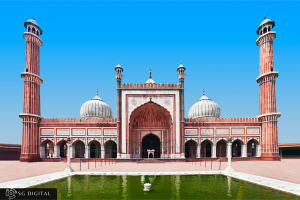
The largest of its kind and one of the most beautiful mosques in India, the Jama Masjid lies next to Chandni Chowk in Old Delhi. More information on Jama Masjid is as below:
- History:
- The Jama Masjid was finally completed in the year 1656 under the commission of Mughal Emperor Shah Jahan and is regarded as one of the last architectural works from the Emperor.
- Jama Masjid is built on a platform of red sandstone, constructed with white marble and red sandstone, giving it a very peculiar appearance.
- Architecture:
- The architecture of Jama Masjid speaks volumes about the Mughal Architecture with loads of elements derived from Persian, Timurid, and Indian.
- The mosque has three giant gates and four towers. The minarets are 40 meters high from the ground level, standing at two each, finely carved in calligraphy and geometric patterns.
- The main prayer hall of the mosque can easily accommodate thousands of worshippers. The central courtyard has space that can accommodate an enormous gathering of people for ceremonies.
- Courtyard and Dome:
- A huge tank (pool) is in the middle of the courtyard for ablution before offering prayers. Besides, to beautify the courtyard, there also stands a reflective pool.
- One of the hugest amongst the many is the main dome of the mosque, and its size encases it around. The main dome is decorated with white marble stripes and capped off with a golden crescent.
- Prayer Hall:
- The prayer hall has a beautiful mihrab (prayer niche) in white marble with inscriptions of Quranic verses.
- The mosque houses a revered relic believed to be the footprint of Prophet Muhammad.
- Festivals and Events:
- Jama Masjid is one of the important centers from a religious as well as cultural point of view. It remains crowded by a huge mass of devotees, especially at big Islamic festivals like Eid ul Fitr and Eid ul Adha.
- It organizes special occasions and prayers in the month of Ramadan.
- Accessibility:
- This mosque is easily accessible, either by road through convenient good connectivity or by metro. The nearest metro station to reach the mosque is at Jama Masjid Metro Station.
- Entry and Dress Code:
- An entry fee for non-Muslim tourists is strictly levied, and dress codes are also required to be adhered to. Modest attire is available for rent at the mosque entrance.
Jama Masjid is one of the symbols of Mughal greatness in architecture, an important religious and architectural spot in Delhi, representing one of the richest cultural and historical heritages of the area to the people.
7. National Museum

The National Museum at New Delhi is the largest of its kind in India and works as a major consolidator of the extensive heritage covering the rich Indian culture and history. Here is some more information about the National Museum.
- Establishment and Location:
- The National Museum was established on 15th August 1949 in the endeavor of conserving and displaying diversified heritage in Indian culture and tradition of arts.
- It is located on Janpath, near India Gate, in the heart of New Delhi.
- Divisions and Galleries:
- The museum is organized into departments and galleries, all with specialization in given periods and cultures or types of art.
- In these are galleries in a wide range of subjects including archaeology, anthropology, decorative arts, manuscripts, paintings, jewelry, and textiles, among others.
- Collections:
- The collection, including artifacts with prehistoric sculptures, paintings, manuscripts, coins, jewelry, textiles, and decorative arts, is designated a part of the national museum.
- The major ones in the collection are Harappan antiquities, Gandhara sculptures, and miniature paintings, besides ancient Indian sculptures.
- Harappan Gallery:
- An exclusive gallery with artifacts that represent one of the oldest cultures of the world, brought forth by the prehistoric site of the ancient Indus Valley Civilization.
- Gandhara Art:
- Artifacts and sculptures in the Gandhara Gallery have characteristics like those of the Greco-Roman mix and Indian style.
- Manuscripts and Paintings:
- Museum containing a wonderful collection of ancient manuscripts and paintings with hundreds representing most of the schools of Indian art. These also include palm leaf manuscripts, rare paintings, and the like.
- Events and Exhibitions:
- Apart from regular special exhibitions, events, and educational programs to promote awareness and appreciation of the cultural heritage
- India have been carried out at the National Museum, New Delhi. Temporary exhibitions may focus on specific themes, historical periods, or art forms..
- Educational Programs:
- The museum conducts a series of educational programs for students and researchers, as well as for the general public. Such programs include workshops, lectures, and guided tours.
- Library and Research Wing:
- The National Museum has a well-stocked library and research wing that helps scholars and researchers in the field of art and culture.
- Accessibility:
- This much-reachable museum with public transport has to be visited by many tourists, scholars, and connoisseurs.
Visitors to the National Museum have the opportunity to explore India’s rich cultural heritage through its diverse and extensive collection of artifacts. The museum plays a crucial role in preserving and promoting the country’s artistic traditions for future generations
8. Lodhi Garden
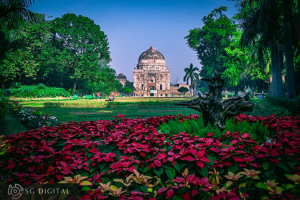
Lodhi Garden, officially known as Lodhi Gardens or Lodhi Estate, is a historic park located in the heart of New Delhi, India. Here’s more information about Lodhi Garden:
- History:
- The Lodhi Gardens is named after the dynasty that reigned in different parts of north India during the 15th century; the monuments found in the park date back to that period. It has some important tombs and buildings dating from the Lodhi period.
- Location:
- Spread over an area of about 90 acres, the garden is located on Lodhi Road near Safdarjung’s Tomb and Khan Market in New Delhi.
- Architectural Monuments:
- Key highlights within the garden include the Tomb of Sikandar Lodi, Mohammed Shah’s Tomb, Sheesh Gumbad (Glass Dome), and Bara Gumbad (Big Dome). These represent a huge range of architectural styles for that time.
- Tomb of Sikandar Lodi:
- It is an octagonal tomb surrounded by beautiful gardens, showcasing its splendor and historical importance.
- Mohammed Shah’s Tomb:
- Being one of the earliest models of garden tombs on the Indian subcontinent, it can be seen to bear Afghan features in its architecture.
- Sheesh Gumbad:
- The glass dome is known to be quite famous, since its dome is covered with glasses that are blue and yellow-tiled, giving it a peculiar and attractive appearance.
- Bara Gumbad:
- This huge structure served as an entrance or congregational hall for the mosque that doesn’t exist today. It’s famous for its big dome and the imposing stature.
- Landscaped Gardens:
- Well-manicured paths, green surrounding lawns, and a peaceful environment made it a place for the majority of the local people and tourists to come for a visit just to escape from city life.
- Flora and Fauna:
- The flora rich didn’t form an aesthetically nice garden but also attracted a variety of kinds of birds; the garden has been a house for most species that have attracted the birds.
- Recreational Activities:
- The garden is perfect for getting an ideal atmosphere for the best morning exercise: walks and jogging, apart from picnics, yoga, and picnics.
- Accessibility:
- The garden is open to the public and provides a very pleasant green area in the middle of New Delhi. This represents the city’s rich historical long and consistent commitment to the cultural heritage and the environment.
Lodhi Garden is not only an epitome of historical significance but also a place of leisure where people can come closer to nature and appreciate the architectural heritage associated with the Lodhi dynasty.
9. Nizamuddin Dargah
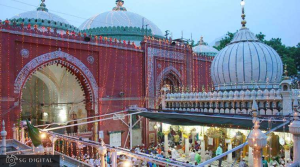
The Nizamuddin Dargah is a revered Sufi shrine located in the Nizamuddin West area of Delhi. Here is more information about this spiritual and cultural landmark:
- Spiritual Significance:
- The Nizamuddin Dargah is dedicated to Hazrat Nizamuddin Auliya, a revered 14th-century Sufi saint and a pivotal figure in Sufi Islam.
- Known for its spiritual ambiance, the dargah is a sanctuary for people of all faiths seeking blessings, solace, and spiritual experiences.
- Architecture:
- The dargah complex features the tomb of Hazrat Nizamuddin Auliya and other notable personalities such as the poet Amir Khusro.
- It showcases a blend of Mughal and Indian architectural styles, with intricate carvings, arches, and a white marble facade that underscore its historical and spiritual significance.
- Qawwali Performances:
- One of the dargah’s highlights is the traditional Qawwali music performances held every Thursday evening following the evening prayers. Qawwali is a form of devotional Sufi music that incorporates poetry praising the divine, contributing to the dargah’s profound spiritual atmosphere.
- Chishti Order of Sufism:
- Hazrat Nizamuddin Auliya was associated with the Chishti Order of Sufism, which emphasizes love, devotion, and a renunciation of materialism.
- The dargah remains a vibrant center for the Chishti Sufi order, drawing devotees and spiritual seekers globally.
- Offerings and Rituals:
- Devotees engage in various acts of devotion such as offering prayers, lighting candles, and tying sacred threads. It is believed that seeking blessings here can bring solace and fulfill wishes.
- The dargah also attracts a large number of visitors during the annual Urs festivals, which commemorate the death anniversaries of Sufi saints.
- Hazrat Nizamuddin Basti:
- Surrounding the dargah is the Hazrat Nizamuddin Basti, an area steeped in history with narrow lanes and old buildings, rich in cultural heritage.
- Additional attractions include the Baoli (stepwell) of Hazrat Nizamuddin Auliya and the tomb of Amir Khusro.
- A Symbol of Harmony:
- The Nizamuddin Dargah stands as a symbol of religious harmony, uniting people from various backgrounds in their search for spiritual solace and engagement with Sufi traditions. This makes it not just a religious site but also a cultural bridge fostering unity and peace.
Visiting the Nizamuddin Dargah provides not only a spiritual experience but also an opportunity to witness the cultural richness and inclusivity that characterize Sufi traditions in India.


